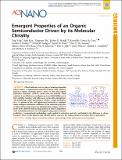Emergent properties of an organic semiconductor driven by its molecular chirality
Abstract
Chiral molecules exist as pairs of nonsuperimposable mirror images; a fundamental symmetry property vastly underexplored in organic electronic devices. Here, we show that organic field-effect transistors (OFETs) made from the helically chiral molecule 1-aza[6]helicene can display up to an 80-fold difference in hole mobility, together with differences in thin-film photophysics and morphology, solely depending on whether a single handedness or a 1:1 mixture of left- and right- handed molecules is employed under analogous fabrication conditions. As the molecular properties of either mirror image isomer are identical, these changes must be a result of the different bulk packing induced by chiral composition. Such underlying structures are investigated using crystal structure prediction, a computational methodology rarely applied to molecular materials, and linked to the difference in charge transport. These results illustrate that chirality may be used as a key tuning parameter in future device applications.
Citation
Yang , Y , Rice , B , Shi , X , Brandt , J R , Correa da Costa , R , Hedley , G J , Smilgies , D-M , Frost , J M , Samuel , I D W , Otero-de-la-Roza , A , Johnson , E R , Jelfs , K E , Nelson , J , Campbell , A J & Fuchter , M J 2017 , ' Emergent properties of an organic semiconductor driven by its molecular chirality ' , ACS Nano , vol. 11 , no. 8 , pp. 8329-8338 . https://doi.org/10.1021/acsnano.7b03540
Publication
ACS Nano
Status
Peer reviewed
ISSN
1936-0851Type
Journal article
Description
Funding: UK EPSRC (EP/I014535/1, EP/L014580/1, EP/P000525/1, EP/P005543/1, EP/K029843/1, EP/K010298/1, EP/J017361/1 and EP/K016288/1). Raw data files from this study are openly available at DOI: 10.6084/m9.figshare.c.3829771.Collections
Items in the St Andrews Research Repository are protected by copyright, with all rights reserved, unless otherwise indicated.

